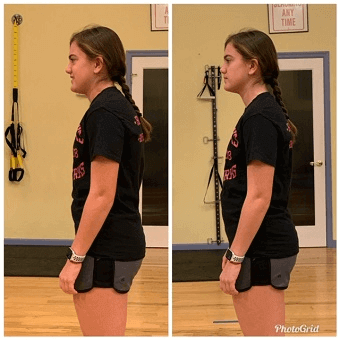Cues for the Core, Good or Bad?

Cues for the core you hear all over the internet and in the gym all the time.
"Draw you belly button in towards your spine".
"Flatten your lower back down to the floor".
These are two cues you hear for the core before you begin just about any exercise. Again these are cues I was taught and cues I even taught my clients back in the day.
If you look closely at the pictures above you may notice some slight differences. In the picture on the left. Bri has more thoracic spine flexion, her neck is more compressed and she stands with more posterior pelvic tilt.
In the picture on the right, her entire upper body from her neck to her pelvis is less compressed and more aligned and her pelvis is much more neutral.
After we took these pictures I asked her if she would want to preform a back squat or an Olympic lift with the cues she used to create the picture on the left. Her answer "no way"!
So, what's the difference?
In the picture on the left she is drawing her belly in, (gently drawing in I might add), not using the hard cue given in most gyms. On the right she is using 3-dimensional breathing and core activation cues we teach as part of the IMS System™.
These non-optimal cues tend to over-recruit muscles in the pelvis, back and upper body. Which in turn creates a non-optimal posture which you see in Bri's picture on the left. The differences are subtle but they are there.
Non-Optimal Cues
As I mentioned earlier I used to teach core activation this exact way. Draw the belly in, flatten the low back to the floor, etc. But as I watched my clients work out, I saw things I didn't like and went in search of a better solution. I have changed the cues for the core I use now.
I had so many clients coming to me with letters from their doctors and therapists telling them that their back pain was simply a product of their weak core muscles. Strengthen your core and eliminate your pain.

If it were only that simple. I have had clients come to me with what I call superhuman strength. I felt like they could curl my entire body with one arm. But, despite all that strength they still came to see me because of their low back pain.
The fact that I couldn't solve my clients problems with more strength, is one of the biggest reasons I went looking for a better solution. As part of the Integrative Movement System™ approach to training the core; I learned very quickly a healthy core has nothing to do with how strong you are. And if you train your core correctly you do not need to use cues such as "flatten your back to the floor" or "brace your core like you are going to take a punch".
The Problem
Core stability is all about using the correct strategy for the task at hand. And being able to seamlessly move between high level and low level strategies depending on the task.
For example, let's say you need to help pick up a piece of furniture. As you squat down you will use a moderate level strategy for your core. As you set yourself you move into a high level strategy to pick up the furniture. Once you set the piece down you go back to your low level strategy.
Most people who suffer from chronic tightness and pain, especially in the low back area are generally using a high level strategy for all activities. They our bracing and gripping down really hard when they are just standing, walking, bending, sitting or even lying down.
In time this over-bracing leads to over recruitment of the superficial muscles and begins to shut down the deep stabilizers of the spine and core.
These faulty motor control patterns are the cause of most back pain issues. When we try to fix this problem with strength exercises you are just adding to the imbalance.
The IMS™ Solution
Now when I have clients come to me with back pain (and really all my clients) I train the core in a much different way.
First, I teach them to control neutral using the A'B'C's (Align, Breathe and Control) in all the low level positions using the least amount of effort necessary. Meaning no bracing or gripping.
Next, we use the same principles and develop a low level strategy for the isometric exercises like a wall plank or supported door squat.
Lastly, when appropriate I incorporate higher level patterns into the workout. At this point you have learned to add the proper amount of stabilization needed for the activity and there is no need for cues such "pulling our belly button in" etc.
If you suffer from low back pain feel free to contact me for a free consultation. Want to learn a few of my low level core exercises download my free eBook Restore Your Core.
Stay Motivated,

